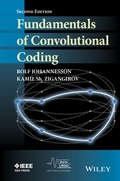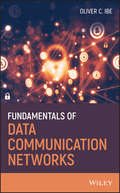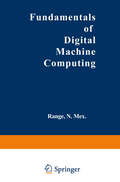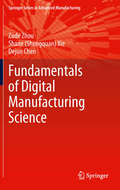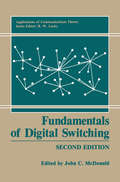- Table View
- List View
Fundamentals of Conjugated Polymer Blends, Copolymers and Composites: Synthesis, Properties, and Applications
by Parveen SainiSince their discovery in 1977, the evolution of conducting polymers has revolutionized modern science and technology. These polymers enjoy a special status in the area of materials science yet they are not as popular among young readers or common people when compared to other materials like metals, paper, plastics, rubber, textiles, ceramics and composites like concrete. Most importantly, much of the available literature in the form of papers, specific review articles and books is targeted either at advanced readers (scientists/technologists/engineers/senior academicians) or for those who are already familiar with the topic (doctoral/postdoctoral scholars). For a beginner or even school/college students, such compilations are bit difficult to access/digest. In fact, they need proper introduction to the topic of conducting polymers including their discovery, preparation, properties, applications and societal impact, using suitable examples and already known principles/knowledge/phenomenon. Further, active participation of readers in terms of “question & answers”, “fill-in-the-blanks”, “numerical” along with suitable answer key is necessary to maintain the interest and to initiate the “thought process”. The readers also need to know about the drawbacks and any hazards of such materials. Therefore, I believe that a comprehensive source on the science/technology of conducting polymers which maintains a link between grass root fundamentals and state-of-the-art R&D is still missing from the open literature.
Fundamentals of Construction Claims: A 9-Step Guide for General Contractors, Subcontractors, Architects, Engineers, and Owners
by William J. McConnellDemystify complicated construction claims with this indispensable guide Given how common complex claims have become in the modern built environment, Fundamentals of Construction Claims: A 10-Step Guide for General Contractors, Subcontractors, Architects and Engineers is an absolutely critical addition to the library of any construction professional. Written by William J. McConnell, PE, JD, MSCE, CDT, a celebrated, lawyer, author, engineer, and expert witness, Fundamentals of Construction Claims sets out clear and concrete strategies for developing a construction claim from beginning to end. The author's straightforward 10-Step method helps readers avoid costly dispute resolution fees by: Explaining entitlement requirements for various types of claims, including differing site conditions, added scope, and weather delays Offering procedures for calculating delay impacts through forensic scheduling analysis Defining, in detail, four simple ways to prove damages Throughout, relevant case studies are used to illuminate the principles found within and bring life to the concepts the author introduces.
Fundamentals of Construction Claims: A 9-Step Guide for General Contractors, Subcontractors, Architects, Engineers, and Owners
by William J. McConnellDemystify complicated construction claims with this indispensable guide Given how common complex claims have become in the modern built environment, Fundamentals of Construction Claims: A 10-Step Guide for General Contractors, Subcontractors, Architects and Engineers is an absolutely critical addition to the library of any construction professional. Written by William J. McConnell, PE, JD, MSCE, CDT, a celebrated, lawyer, author, engineer, and expert witness, Fundamentals of Construction Claims sets out clear and concrete strategies for developing a construction claim from beginning to end. The author's straightforward 10-Step method helps readers avoid costly dispute resolution fees by: Explaining entitlement requirements for various types of claims, including differing site conditions, added scope, and weather delays Offering procedures for calculating delay impacts through forensic scheduling analysis Defining, in detail, four simple ways to prove damages Throughout, relevant case studies are used to illuminate the principles found within and bring life to the concepts the author introduces.
Fundamentals of Continuum Mechanics of Soils
by Yehuda KlausnerFundamentals of Continuum Mechanics of Soils provides a long-needed general scheme for the study of the important yet problematic material of soil. It closes the gap between two disciplines, soil mechanics and con- tinuum mechanics, showing that the familiar concepts of soil mechanics evolve directly from continuum mechanics. It confirms concepts such as pore pressures, cohesion and dependence of the shear stress on consolidation, and rejects the view that continuum mechanics cannot be applied to a material such as soil. The general concepts of continuum mechanics, field equations and constitutive equations are discussed. It is shown how the theory of mixtures evolves from these equations and how, along with energetics and irrevers- ible thermodynamics, it can be applied to soils. The discussion also sheds light on some aspects of mechanics of materials, especially compressible materials. Examples are the introduction of the Hencky measure of strain, the requirement of dual constitutive equations, and the dependence of the spent internal energy on the stored internal energy. Researchers in engineering mechanics and material sciences may find that the results of experiments on soils can be generalized and extended to other materials. The book is a reference text for students familiar with the fundamentals of mechanics, for scholars of soil engineering, and for soil scientists. It is also suitable as an advanced undergraduate course in soil mechanics.
Fundamentals of Convective Heat Transfer
by Vijay K. Dhir Gautam Biswas Amaresh DalalThermal convection is often encountered by scientists and engineers while designing or analyzing flows involving exchange of energy. Fundamentals of Convective Heat Transfer is a unified text that captures the physical insight into convective heat transfer and thorough, analytical, and numerical treatments. It also focuses on the latest developments in the theory of convective energy and mass transport. Aimed at graduates, senior undergraduates, and engineers involved in research and development activities, the book provides new material on boiling, including nuances of physical processes. In all the derivations, step-by-step and systematic approaches have been followed.
Fundamentals of Convective Heat Transfer
by Vijay K. Dhir Gautam Biswas Amaresh DalalThermal convection is often encountered by scientists and engineers while designing or analyzing flows involving exchange of energy. Fundamentals of Convective Heat Transfer is a unified text that captures the physical insight into convective heat transfer and thorough, analytical, and numerical treatments. It also focuses on the latest developments in the theory of convective energy and mass transport. Aimed at graduates, senior undergraduates, and engineers involved in research and development activities, the book provides new material on boiling, including nuances of physical processes. In all the derivations, step-by-step and systematic approaches have been followed.
Fundamentals of Convolutional Coding (IEEE Series on Digital & Mobile Communication)
by Rolf Johannesson Kamil Sh. ZigangirovFundamentals of Convolutional Coding, Second Edition, regarded as a bible of convolutional coding brings you a clear and comprehensive discussion of the basic principles of this field Two new chapters on low-density parity-check (LDPC) convolutional codes and iterative coding Viterbi, BCJR, BEAST, list, and sequential decoding of convolutional codes Distance properties of convolutional codes Includes a downloadable solutions manual
Fundamentals of Convolutional Coding (IEEE Series on Digital & Mobile Communication)
by Rolf Johannesson Kamil Sh. ZigangirovFundamentals of Convolutional Coding, Second Edition, regarded as a bible of convolutional coding brings you a clear and comprehensive discussion of the basic principles of this field Two new chapters on low-density parity-check (LDPC) convolutional codes and iterative coding Viterbi, BCJR, BEAST, list, and sequential decoding of convolutional codes Distance properties of convolutional codes Includes a downloadable solutions manual
Fundamentals of Crystal Growth I: Macroscopic Equilibrium and Transport Concepts (Springer Series in Solid-State Sciences #5)
by Franz E. RosenbergerThe intrinsic properties of a solid, i. e. , the properties that result from its specific structure, can be largely modified by crystallographic and chem ical defects. The formation of these defects is governed by the heat and mass transfer conditions which prevail on and near a crystal-nutrient in terface during crystallization. Hence, both the growth of highly perfect crystals and the preparation of samples having predetermined defect-induced (extrinsic) properties require a thorough understanding of the reaction and transport mechanisms that govern crystallization from vapors, solutions and melts. Crystal growth, as a science, is therefore mostly concerned with the chemistry and physics of heat and mass transport in these fluid-solid phase transitions. Solid-solid transitions are, at this time, not widely employed for high quality single-crystal production. Transport concepts are largely built upon equilibrium considerations, i. e. , on thermodynamic and phase equilibrium concepts. Hence to supply a "workable" foundation for the succeeding discussions, this text begins in Chapter 2 with a concise treatment of thermodynamics which emphasizes applications to mate rials preparation. After working through this chapter, the reader should feel at ease with often (particularly among physicists) unfamiliar entities such as chemical potentials, fugacities, activities. etc. Special sections on ther mochemical calculations (and their pitfalls) and compilations of thermochemi cal data conclude the second chapter. Crystal growth can be called. in a wide sense, the science and technology of controlling phase transitions that lead to (single crystalline) solids.
Fundamentals of Crystallography, Powder X-ray Diffraction, and Transmission Electron Microscopy for Materials Scientists (Advances in Materials Science and Engineering)
by Dong ZhiLiThe structure–property relationship is a key topic in materials science and engineering. To understand why a material displays certain behaviors, the first step is to resolve its crystal structure and reveal its structure characteristics. Fundamentals of Crystallography, Powder X-ray Diffraction, and Transmission Electron Microscopy for Materials Scientists equips readers with an in-depth understanding of using powder x-ray diffraction and transmission electron microscopy for the analysis of crystal structures. Introduces fundamentals of crystallography Covers XRD of materials, including geometry and intensity of diffracted x-ray beams and experimental methods Describes TEM of materials and includes atomic scattering factors, electron diffraction, and diffraction and phase contrasts Discusses applications of HRTEM in materials research Explains concepts used in XRD and TEM lab training Based on the author’s course lecture notes, this text guides materials science and engineering students with minimal reliance on advanced mathematics. It will also appeal to a broad spectrum of readers, including researchers and professionals working in the disciplines of materials science and engineering, applied physics, and chemical engineering.
Fundamentals of Crystallography, Powder X-ray Diffraction, and Transmission Electron Microscopy for Materials Scientists (Advances in Materials Science and Engineering)
by Dong ZhiLiThe structure–property relationship is a key topic in materials science and engineering. To understand why a material displays certain behaviors, the first step is to resolve its crystal structure and reveal its structure characteristics. Fundamentals of Crystallography, Powder X-ray Diffraction, and Transmission Electron Microscopy for Materials Scientists equips readers with an in-depth understanding of using powder x-ray diffraction and transmission electron microscopy for the analysis of crystal structures. Introduces fundamentals of crystallography Covers XRD of materials, including geometry and intensity of diffracted x-ray beams and experimental methods Describes TEM of materials and includes atomic scattering factors, electron diffraction, and diffraction and phase contrasts Discusses applications of HRTEM in materials research Explains concepts used in XRD and TEM lab training Based on the author’s course lecture notes, this text guides materials science and engineering students with minimal reliance on advanced mathematics. It will also appeal to a broad spectrum of readers, including researchers and professionals working in the disciplines of materials science and engineering, applied physics, and chemical engineering.
Fundamentals of Dairy Chemistry
by Noble P. WongFundamentals of Dairy Chemistry has always been a reference text which has attempted to provide a complete treatise on the chemistry of milk and the relevant research. The third edition carries on in that format which has proved successful over four previous editions (Fun damentals of Dairy Science 1928, 1935 and Fundamentals of Dairy Chemistry 1965, 1974). Not only is the material brought up-to-date, indeed several chapters have been completely re-written, but attempts have been made to streamline this edition. In view of the plethora of research related to dairy chemistry, authors were asked to reduce the number of references by eliminating the early, less significant ones. In addition, two chapters have been replaced with subjects which we felt deserved attention: "Nutritive Value of Dairy Foods" and "Chemistry of Processing. " Since our society is now more attuned to the quality of the food it consumes and the processes necessary to preserve that quality, the addition of these topics seemed justified. This does not minimize the importance of the information in the deleted chapters, "Vitamins of Milk" and "Frozen Dairy Products. " Some of the mate rial in these previous chapters has been incorporated into the new chapters; furthermore, the information in these chapters is available in the second edition, as a reprint from ADSA (Vitamins in Milk and Milk Products, November 1965) or in the many texts on ice cream manufac ture.
Fundamentals of Data Communication Networks
by Oliver C. IbeWhat every electrical engineering student and technical professional needs to know about data exchange across networks While most electrical engineering students learn how the individual components that make up data communication technologies work, they rarely learn how the parts work together in complete data communication networks. In part, this is due to the fact that until now there have been no texts on data communication networking written for undergraduate electrical engineering students. Based on the author’s years of classroom experience, Fundamentals of Data Communication Networks fills that gap in the pedagogical literature, providing readers with a much-needed overview of all relevant aspects of data communication networking, addressed from the perspective of the various technologies involved. The demand for information exchange in networks continues to grow at a staggering rate, and that demand will continue to mount exponentially as the number of interconnected IoT-enabled devices grows to an expected twenty-six billion by the year 2020. Never has it been more urgent for engineering students to understand the fundamental science and technology behind data communication, and this book, the first of its kind, gives them that understanding. To achieve this goal, the book: Combines signal theory, data protocols, and wireless networking concepts into one text Explores the full range of issues that affect common processes such as media downloads and online games Addresses services for the network layer, the transport layer, and the application layer Investigates multiple access schemes and local area networks with coverage of services for the physical layer and the data link layer Describes mobile communication networks and critical issues in network security Includes problem sets in each chapter to test and fine-tune readers’ understanding Fundamentals of Data Communication Networks is a must-read for advanced undergraduates and graduate students in electrical and computer engineering. It is also a valuable working resource for researchers, electrical engineers, and technical professionals.
Fundamentals of Data Communication Networks
by Oliver C. IbeWhat every electrical engineering student and technical professional needs to know about data exchange across networks While most electrical engineering students learn how the individual components that make up data communication technologies work, they rarely learn how the parts work together in complete data communication networks. In part, this is due to the fact that until now there have been no texts on data communication networking written for undergraduate electrical engineering students. Based on the author’s years of classroom experience, Fundamentals of Data Communication Networks fills that gap in the pedagogical literature, providing readers with a much-needed overview of all relevant aspects of data communication networking, addressed from the perspective of the various technologies involved. The demand for information exchange in networks continues to grow at a staggering rate, and that demand will continue to mount exponentially as the number of interconnected IoT-enabled devices grows to an expected twenty-six billion by the year 2020. Never has it been more urgent for engineering students to understand the fundamental science and technology behind data communication, and this book, the first of its kind, gives them that understanding. To achieve this goal, the book: Combines signal theory, data protocols, and wireless networking concepts into one text Explores the full range of issues that affect common processes such as media downloads and online games Addresses services for the network layer, the transport layer, and the application layer Investigates multiple access schemes and local area networks with coverage of services for the physical layer and the data link layer Describes mobile communication networks and critical issues in network security Includes problem sets in each chapter to test and fine-tune readers’ understanding Fundamentals of Data Communication Networks is a must-read for advanced undergraduates and graduate students in electrical and computer engineering. It is also a valuable working resource for researchers, electrical engineers, and technical professionals.
Fundamentals of Deep Excavations
by Chang-Yu OuExcavation is an important segment of foundation engineering (e.g., in the construction of the foundations or basements of high-rise buildings, underground oil tanks, or subways). However, the excavation knowledge introduced in most books on foundation engineering is too simple to handle actual excavation analysis and design. Moreover, with economic development and urbanization, excavations go deeper and are larger in scale. These conditions require elaborate analysis, design methods and construction technologies. This book is aimed at both theoretical explication and practical application. From basic to advanced, this book attempts to achieve theoretical rigor and consistency. Each chapter is followed by a problem set so that the book can be readily taught at senior undergraduate and graduate levels. The solution to the problems at the end of the chapters can be found on the website (http://www.ct.ntust.edu.tw/ou/). On the other hand, the analysis methods introduced in the book can be used in actual analysis and design as they contain the most up-to-date knowledge. Therefore, this book is suitable for teachers who teach foundation engineering and/or deep excavation courses and engineers who are engaged in excavation analysis and design.
Fundamentals of Deep Excavations
by Chang-Yu OuExcavation is an important segment of foundation engineering (e.g., in the construction of the foundations or basements of high-rise buildings, underground oil tanks, or subways). However, the excavation knowledge introduced in most books on foundation engineering is too simple to handle actual excavation analysis and design. Moreover, with economic development and urbanization, excavations go deeper and are larger in scale. These conditions require elaborate analysis, design methods and construction technologies. This book is aimed at both theoretical explication and practical application. From basic to advanced, this book attempts to achieve theoretical rigor and consistency. Each chapter is followed by a problem set so that the book can be readily taught at senior undergraduate and graduate levels. The solution to the problems at the end of the chapters can be found on the website (http://www.ct.ntust.edu.tw/ou/). On the other hand, the analysis methods introduced in the book can be used in actual analysis and design as they contain the most up-to-date knowledge. Therefore, this book is suitable for teachers who teach foundation engineering and/or deep excavation courses and engineers who are engaged in excavation analysis and design.
The Fundamentals of Density Functional Theory (Teubner Texte zur Physik #32)
by Helmut EschrigDensity functional methods form the basis of a diversified and very active area of present days computational atomic, molecular, solid state and even nuclear physics. A large number of computational physicists use these meth ods merely as a recipe, not reflecting too much upon their logical basis. One also observes, despite of their tremendeous success, a certain reservation in their acceptance on the part of the more theoretically oriented researchers in the above mentioned fields. On the other hand, in the seventies (Thomas Fermi theory) and in the eighties (Hohenberg-Kohn theory), density func tional concepts became subjects of mathematical physics. In 1994 a number of activities took place to celebrate the thirtieth an niversary of Hohenberg-Kohn-Sham theory. I took this an occassion to give lectures on density functional theory to senior students and postgraduates in the winter term of 1994, particularly focusing on the logical basis of the the ory. Preparing these lectures, the impression grew that, although there is a wealth of monographs and reviews in the literature devoted to density func tional theory, the focus is nearly always placed upon extending the practical applications of the theory and on the development of improved approxima tions. The logical foundadion of the theory is found somewhat scattered in the existing literature, and is not always satisfactorily presented. This situation led to the idea to prepare a printed version of the lecture notes, which resulted in the present text.
Fundamentals of Differential Beamforming (SpringerBriefs in Electrical and Computer Engineering)
by Jacob Benesty Jingdong Chen Chao PanThis book provides a systematic study of the fundamental theory and methods of beamforming with differential microphone arrays (DMAs), or differential beamforming in short. It begins with a brief overview of differential beamforming and some popularly used DMA beampatterns such as the dipole, cardioid, hypercardioid, and supercardioid, before providing essential background knowledge on orthogonal functions and orthogonal polynomials, which form the basis of differential beamforming. From a physical perspective, a DMA of a given order is defined as an array that measures the differential acoustic pressure field of that order; such an array has a beampattern in the form of a polynomial whose degree is equal to the DMA order. Therefore, the fundamental and core problem of differential beamforming boils down to the design of beampatterns with orthogonal polynomials. But certain constraints also have to be considered so that the resulting beamformer does not seriously amplify the sensors’ self noise and the mismatches among sensors. Accordingly, the book subsequently revisits several performance criteria, which can be used to evaluate the performance of the derived differential beamformers. Next, differential beamforming is placed in a framework of optimization and linear system solving, and it is shown how different beampatterns can be designed with the help of this optimization framework. The book then presents several approaches to the design of differential beamformers with the maximum DMA order, with the control of the white noise gain, and with the control of both the frequency invariance of the beampattern and the white noise gain. Lastly, it elucidates a joint optimization method that can be used to derive differential beamformers that not only deliver nearly frequency-invariant beampatterns, but are also robust to sensors’ self noise.
Fundamentals of Digital Electronics (Lecture Notes in Electrical Engineering #623)
by Dhanasekharan NatarajanThis book presents the fundamentals of digital electronics in a focused and comprehensivemanner with many illustrations for understanding of the subject with high clarity. DigitalSignal Processing (DSP) application information is provided for many topics of the subjectto appreciate the practical significance of learning. To summarize, this book lays afoundation for students to become DSP engineers.
Fundamentals of Digital Imaging in Medicine
by Roger BourneIn general, image processing texts are intended for students of engineering and computer science, and there is little written at all on the specific requirements of medical image processing. Students of medical radiation science (Diagnostic radiography, Nuclear medicine, Radiation therapy) usually have minimal mathematical and computer science training and find the available texts incomprehensible. A text that explains the principles of image processing in minimally-mathematical language is needed for these students. Contrary to the claims of some textbook authors, the vast majority of technologists that process images do not need to understand the mathematics involved, but would nevertheless benefit from a thorough understanding of the general process.
Fundamentals of Digital Logic and Microcontrollers
by M. RafiquzzamanUpdated to reflect the latest advances in the field, the Sixth Edition of Fundamentals of Digital Logic and Microcontrollers further enhances its reputation as the most accessible introduction to the basic principles and tools required in the design of digital systems. Features updates and revision to more than half of the material from the previous edition Offers an all-encompassing focus on the areas of computer design, digital logic, and digital systems, unlike other texts in the marketplace Written with clear and concise explanations of fundamental topics such as number system and Boolean algebra, and simplified examples and tutorials utilizing the PIC18F4321 microcontroller Covers an enhanced version of both combinational and sequential logic design, basics of computer organization, and microcontrollers
Fundamentals of Digital Logic and Microcontrollers
by M. RafiquzzamanUpdated to reflect the latest advances in the field, the Sixth Edition of Fundamentals of Digital Logic and Microcontrollers further enhances its reputation as the most accessible introduction to the basic principles and tools required in the design of digital systems. Features updates and revision to more than half of the material from the previous edition Offers an all-encompassing focus on the areas of computer design, digital logic, and digital systems, unlike other texts in the marketplace Written with clear and concise explanations of fundamental topics such as number system and Boolean algebra, and simplified examples and tutorials utilizing the PIC18F4321 microcontroller Covers an enhanced version of both combinational and sequential logic design, basics of computer organization, and microcontrollers
Fundamentals of Digital Manufacturing Science (Springer Series in Advanced Manufacturing)
by Zude Zhou Shane (Shengquan) Xie Dejun ChenThe manufacturing industry will reap significant benefits from encouraging the development of digital manufacturing science and technology. Digital Manufacturing Science uses theorems, illustrations and tables to introduce the definition, theory architecture, main content, and key technologies of digital manufacturing science. Readers will be able to develop an in-depth understanding of the emergence and the development, the theoretical background, and the techniques and methods of digital manufacturing science. Furthermore, they will also be able to use the basic theories and key technologies described in Digital Manufacturing Science to solve practical engineering problems in modern manufacturing processes.Digital Manufacturing Science is aimed at advanced undergraduate and postgraduate students, academic researchers and researchers in the manufacturing industry. It allows readers to integrate the theories and technologies described with their own research works, and to propose new ideas and new methods to improve the theory and application of digital manufacturing science.
Fundamentals of Digital Switching (Applications of Communications Theory)
by John C. McDonaldSince the publication of the first edition of Fundamentals of Digital Switching in 1983, there has been substantial improvement in digital switching technology and in digital networks. Packet switching has advanced from a low-speed data-oriented switching approach into a robust broadband technology which supports services ranging from low-speed data to video. This technology has eclipsed the flexibility of circuit switching. Fiber optic cable has advanced since the first edition and has substantially changed the technology of transmission. to research in optical devices to find a still better means of This success has led switching. Digital switching systems continue to benefit from the 100-fold improvement in the capabilities of semiconductor devices which has occurred during the past decade. The chip industry forecasts a similar escalation in complexity during the next 10 years. Networks of switching systems have changed due to regulatory policy reform in many nations, including the breakup of the Bell System in the United States, the introduction of new types of carriers in Japan, competition in the United Kingdom, and a reexamination of public policy in virtually all nations. Standards bodies have been productive in specifying new capabilities for future networks involving interactive and distributive services through STM and A TM technologies.




